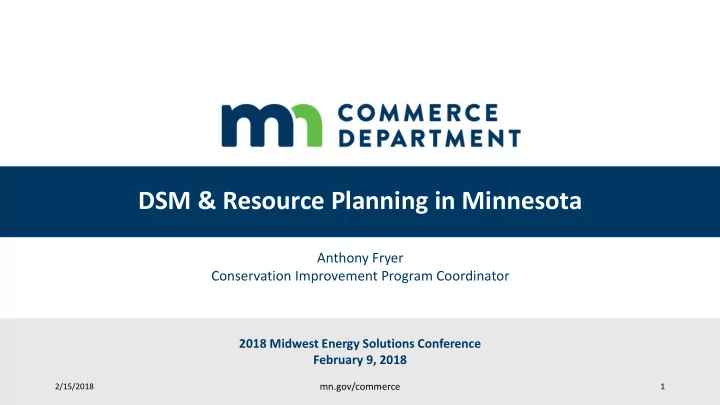

DSM & Resource Planning in Minnesota Anthony Fryer Conservation Improvement Program Coordinator 2018 Midwest Energy Solutions Conference February 9, 2018 2/15/2018 mn.gov/commerce 1
Minnesota Energy Policy Goals • Emissions Reduction - Reduce greenhouse gas emissions by 15 percent by 2015, 30 percent by 2030, and 80 percent by 2050 relative to year 2005 emissions. • EERS - Energy-saving goals for electric and natural gas utilities (1.5 percent of annual retail sales) that operate in the state of Minnesota through the Conservation Improvement Program (CIP). • RES - A goal that twenty-five percent of electric utilities’ total retail sales be met from renewable energy resources by the year 2025. • SES - A requirement that all public utilities generate or procure 1.5 percent of electric generation through solar energy by the year 2020.
Energy Efficiency as a Resource Energy Savings Policy Goal: The legislature finds that energy savings are an energy resource, and that cost- effective energy savings are preferred over all other energy resources…[and] energy savings should be procured systematically and aggressively… Objectives: • Reduce utility costs for businesses and residents • Improve competitiveness and profitability of businesses • Create more energy related jobs • Reduce economic burden of fuel imports • Reduce pollution and emissions that cause climate change Minnesota Statute § 216B.2401 Amended by Article 12, Sec. 2 of HF 729 (4 th ) - 2013
Minnesota Utilities • 7 investor owned utilities • 65% of electricity sales, majority of gas sales • 44 distribution cooperatives • 20% of electricity sales • 130 municipal utilities • 15% of electricity sales 4
CIP Plan and Performance Reviews • IOU CIP Triennial Plans and Status Reports • Currently in 2017-2019 triennial period • Triennial plans submitted June 1 in year prior to new triennial period • Annual status reports submitted March 1 (electric)/April 1 (natural gas) • Muni and Coop CIP Annual Reports and Plans • Report for previous year/plans for next year, submitted June 1 5
CIP IOU Plan Review 6
CIP Electric Results 2010-2016 $180 1,200 Incremental Energy Savings (GWh) 1.7% $160 1.7% 1.7% 1.6% 1,000 1.6% 1.5% $140 Expenditures ($1M) 1.4% $120 800 $100 600 $80 $60 400 $40 200 $20 $0 0 2010 2011 2012 2013 2014 2015 2016 Expenditures Savings 7
Minnesota IRP Overview • Passed in 1993 (216B.2422), and amended numerous times since • Originally called Least Cost Planning; modified to integrate demand- side with supply-side resources – DSM as a resource • Minnesota IRPs use information to identify: • Size, type and timing of energy needs and resources • Least cost supply, energy efficiency, and demand response options considering environmental effects 2/15/2018 mn.gov/commerce 8
Minnesota IRP Process • All G&T utilities file roughly every two years, including • 5-year action plan (near-term actionable investments) • Planning horizon of 15 years • Commission decisions are binding on IOUs (Minnesota Power, Otter Tail Power, and Xcel Energy) • Commission gives non-binding advice to 5 cooperative and municipal G&T utilities • PUC uses review and comment process, allowing broad participation 2/15/2018 mn.gov/commerce 9
Minnesota Electricity Consumption by Source
Complementary Efforts: CIP Results and Plans Informing IRP Development CIP provides PUC and stakeholders with detailed, utility specific DSM information: • Utility CIP annual status reports • Utility triennial/annual plans • Energy Savings Platform with 8 years of program level data 2/15/2018 mn.gov/commerce 11
Complimentary Efforts: CIP Supply and DSM Potential Studies Demand-side potential study: 1. CARD Statewide Natural Gas & Electric Demand- Potential Study Side Efficiency Energy Supply-side (utility infrastructure Optimization efficiency) studies: 1. CARD Electric Utility Infrastructure Supply- Potential Study Side Efficiency 2. U.S. DOE Electric Utility Infrastructure Policy Exploration
Complementary Efforts: IRP Process Driving Utilities Beyond CIP Requirements Through IRP process, PUC can: • Require utility DSM efforts beyond EERS, enhancing utility CIP performance • Consider programs being implemented by other Minnesota utilities and utilities around the country • Direct utilities to increase efforts with CIP opt-out customers 2/15/2018 mn.gov/commerce 13
Lessons Learned • Combination of DSM and IRP highly beneficial • Separate regulators for DSM and IRP processes has pros and cons • Coordination of CIP and IRP development timelines could be helpful • Early collaboration between utilities and stakeholders could shorten and enhance IRP development process 2/15/2018 mn.gov/commerce 14
Thank You Anthony Fryer Anthony Fryer Coordinator – Conservation Improvement Program Conservation Improvement Program Coordinator Minnesota Commerce Department Minnesota Department of Commerce anthony.fryer@state.mn.us – 651.539.1858 anthony.fryer@state.mn.us – 651.539.1858 15
Recommend
More recommend